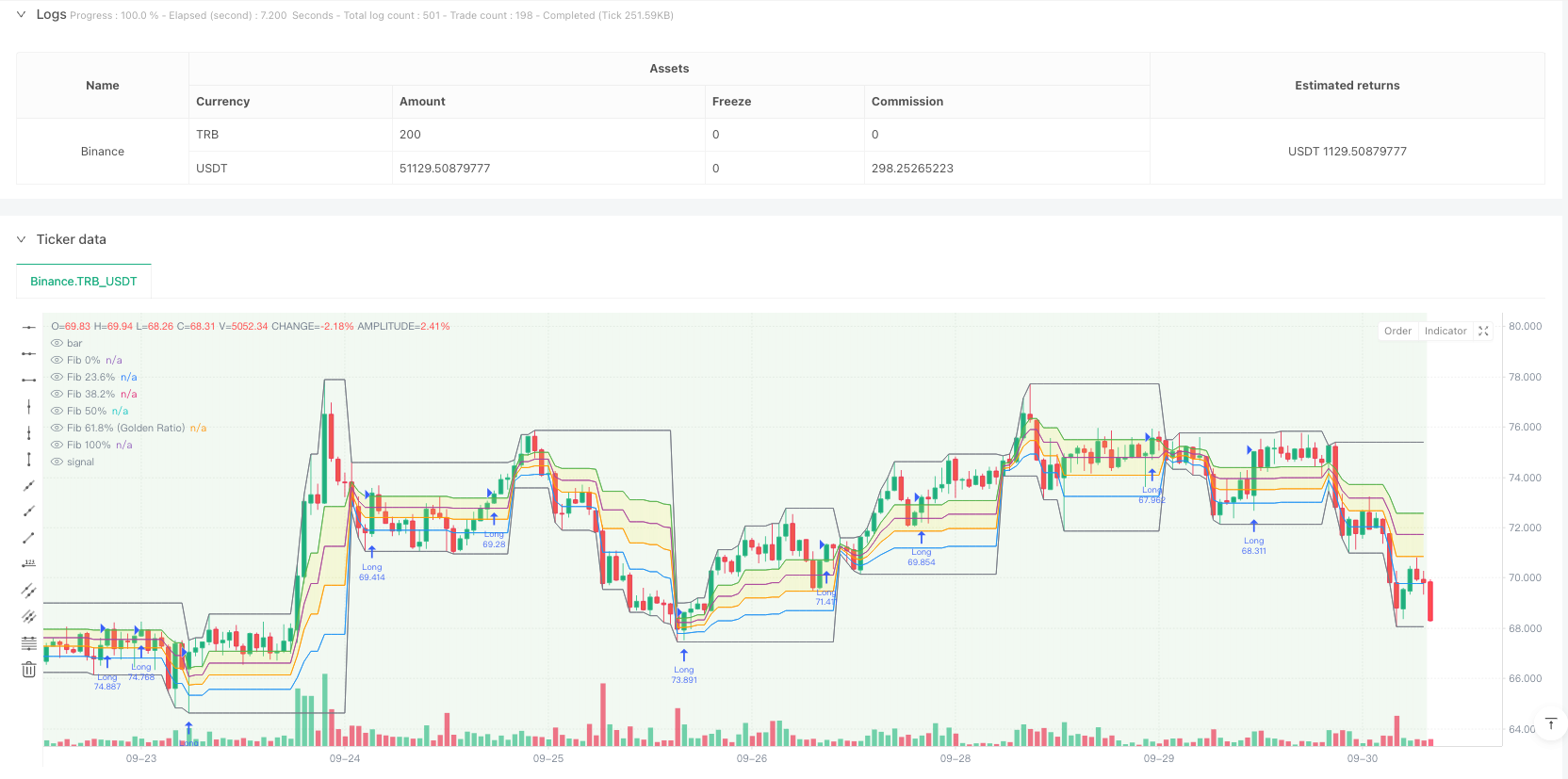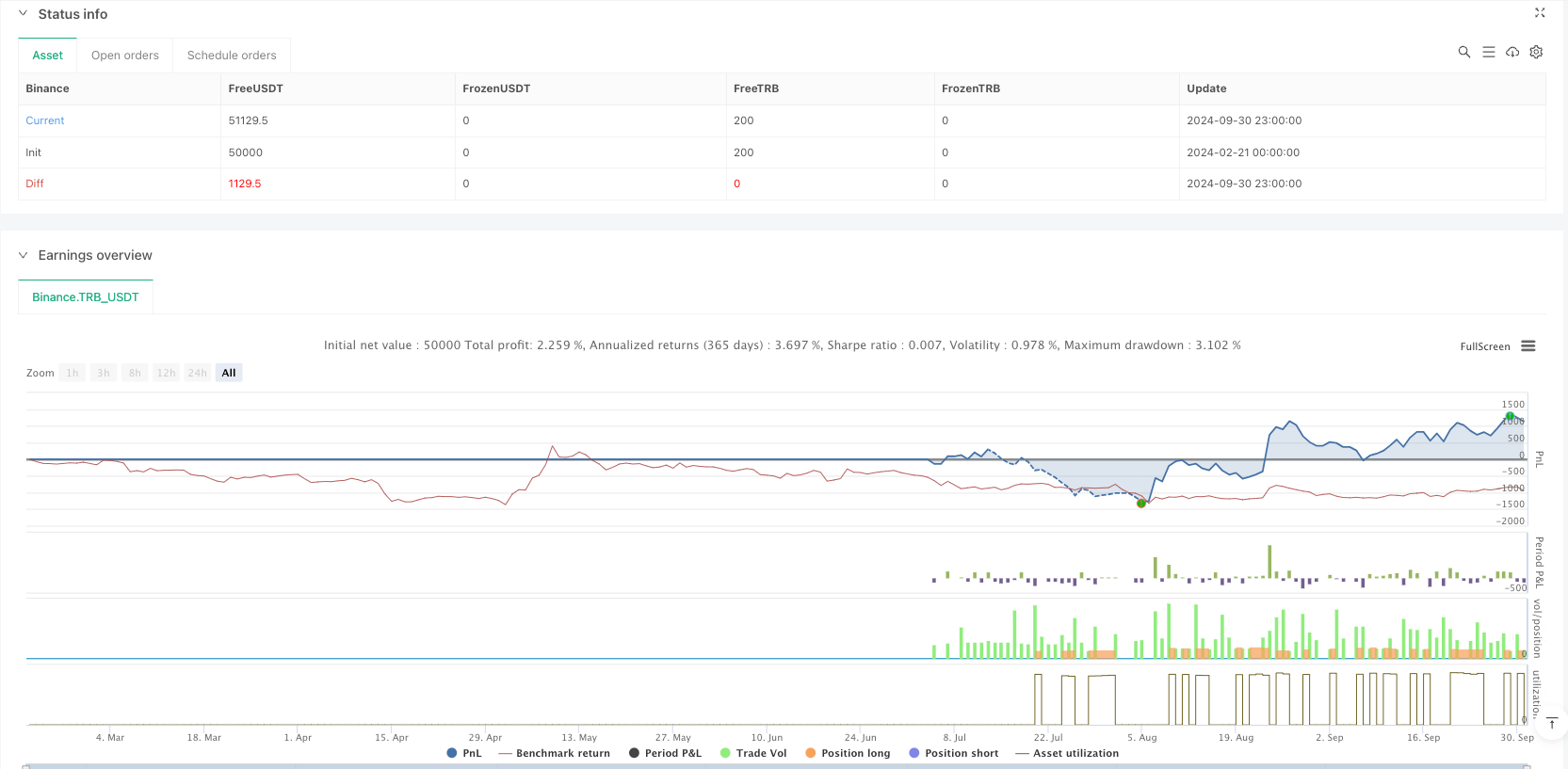

概述
这是一个结合了赫斯特指数(Hurst Exponent)和斐波那契回撤水平的创新型多时间周期交易策略。该策略通过计算不同时间周期的赫斯特指数来评估市场趋势特性,并结合斐波那契关键价格水平来识别潜在的交易机会。策略采用了严格的风险管理框架,包括固定风险比例、目标盈亏比以及每日和总体交易频率限制。
策略原理
策略的核心逻辑基于两个主要组成部分: 1. 通过计算当前和更高时间周期的赫斯特指数来评估市场趋势性质。赫斯特指数大于0.5表示市场具有趋势持续性,小于0.5则表示市场可能存在均值回归特性。 2. 利用每日高低点计算关键的斐波那契回撤水平,重点关注61.8%(黄金分割)和38.2%两个水平。当日线赫斯特指数大于0.5且价格突破61.8%水平时,触发做多信号;当日线赫斯特指数小于0.5且价格跌破38.2%水平时,触发做空信号。
策略优势
- 多维度分析: 通过结合不同时间周期的趋势分析和价格水平,提供更全面的市场视角
- 风险管理完善: 采用固定风险比例(2%)和目标盈亏比(1:2)的风险管理框架
- 交易频率控制: 设置每日最大交易次数和总交易次数限制,避免过度交易
- 可视化辅助: 提供实时的市场趋势背景颜色变化和关键指标信息表格
策略风险
- 市场环境依赖: 在趋势不明显的横盘市场中可能表现欠佳
- 参数敏感性: 赫斯特指数计算周期和斐波那契时间周期的选择会影响策略表现
- 滑点影响: 在流动性较差的市场条件下,可能面临较大的滑点风险
- 系统复杂性: 多个组件的组合增加了策略失效的可能性
策略优化方向
- 动态参数调整: 可以根据市场波动率自动调整赫斯特指数计算周期
- 增加过滤器: 引入额外的市场状态过滤器,提高信号质量
- 优化持仓管理: 实现基于波动率的动态仓位管理
- 改进出场机制: 开发更灵活的盈利目标设置方式
总结
这是一个将技术分析经典工具与现代量化方法相结合的创新策略。通过多时间周期分析和严格的风险管理,策略在保持理论基础的同时也注重实战可行性。虽然存在一定的优化空间,但总体框架具有良好的延展性和实用价值。
策略源码
/*backtest
start: 2024-02-21 00:00:00
end: 2024-10-01 00:00:00
period: 1h
basePeriod: 1h
exchanges: [{"eid":"Binance","currency":"TRB_USDT"}]
*/
//@version=5
// Advanced Multi-Timeframe Trading System (Risk Managed)
//
// Description:
// This strategy combines an approximate measure of market trending via a Hurst exponent
// calculation with Fibonacci retracement levels derived from a higher timeframe (default: Daily)
// to identify potential reversal zones and trade opportunities. The Hurst exponent is calculated
// as a rough indicator of market persistence, while the Fibonacci retracement levels provide potential
// support and resistance areas.
//
// Signal Logic:
// - A long entry is signaled when the price crosses above the 61.8% Fibonacci level (Golden Ratio)
// and the daily Hurst exponent is above 0.5 (suggesting a trending market).
// - A short entry is signaled when the price crosses below the 38.2% Fibonacci level and the daily Hurst
// exponent is below 0.5.
//
// Risk Management:
// Each trade is risk-managed with a stop-loss set at 2% below (or above for shorts) the entry price,
// and a take profit order is set to achieve a 1:2 risk-reward ratio. Position sizing is fixed at 10% of
// equity per trade. Additionally, the strategy limits trading to a maximum of 5 trades per day and 510 trades
// overall (for backtesting since 2019) to ensure a realistic number of orders.
//
// Backtesting Parameters:
// - Initial Capital: $10,000
// - Commission: 0.1% per trade
// - Slippage: 1 tick per bar
// - Position Sizing: 10% of equity per trade
//
// Disclaimer:
// Past performance is not indicative of future results. This strategy is experimental and is provided solely
// for educational purposes. Use caution and perform your own testing before any live deployment.
//
// Author: [Your Name]
// Date: [Date]
strategy("Advanced Multi-Timeframe Trading System (Risk Managed)",
overlay=true,
max_bars_back=500,
initial_capital=10000,
default_qty_type=strategy.percent_of_equity,
default_qty_value=10, // 10% of equity per trade
commission_type=strategy.commission.percent,
commission_value=0.1, // 0.1% commission per trade
slippage=1, // 1 tick per bar
calc_on_order_fills=true,
calc_on_every_tick=true)
// ─── INPUTS ─────────────────────────────────────────────────────────────
hurstLen = input.int(50, title="Hurst Lookback Period", minval=10)
fibTF = input.timeframe("D", title="Fibonacci Retracement Timeframe")
maxTradesPerDay = input.int(5, title="Max Trades Per Day", minval=1)
maxTotalTrades = input.int(510, title="Max Total Trades since 2019", minval=1)
riskPerc = input.float(2.0, title="Risk Percent per Trade (%)", step=0.1) * 0.01 // 2% risk per trade
rrRatio = input.float(2.0, title="Risk-Reward Ratio", step=0.1) // Target profit = 2x risk
// ─── FUNCTION: Approximate Hurst Exponent Calculation ──────────────────────
// This function uses a simple rescaled range method to approximate the Hurst exponent.
// Note: This is an experimental calculation and should be interpreted as a rough gauge of market trending.
calcHurst(src, len) =>
mean = ta.sma(src, len)
dev = src - mean
cumDev = 0.0
for i = 0 to len - 1
cumDev := cumDev + dev[i]
R = ta.highest(cumDev, len) - ta.lowest(cumDev, len)
S = ta.stdev(src, len)
hurst = na(S) or S == 0 ? na : math.log(R / S) / math.log(len)
hurst
// Calculate the Hurst exponent on the current timeframe and from a higher timeframe (daily)
currHurst = calcHurst(close, hurstLen)
dailyHurst = request.security(syminfo.tickerid, "D", calcHurst(close, hurstLen))
// ─── FIBONACCI RETRACEMENT LEVELS (WITH GOLDEN RATIO) ──────────────────────────
// Retrieve the daily high/low from the selected timeframe (default: Daily)
dHigh = request.security(syminfo.tickerid, fibTF, high)
dLow = request.security(syminfo.tickerid, fibTF, low)
// Define Fibonacci levels between the daily low and high.
fib_0 = dLow
fib_100 = dHigh
fib_236 = dLow + 0.236 * (dHigh - dLow)
fib_382 = dLow + 0.382 * (dHigh - dLow)
fib_500 = dLow + 0.5 * (dHigh - dLow)
fib_618 = dLow + 0.618 * (dHigh - dLow) // Golden ratio level
// Plot the Fibonacci levels for reference.
pFib0 = plot(fib_0, color=color.gray, title="Fib 0%")
pFib236 = plot(fib_236, color=color.blue, title="Fib 23.6%")
pFib382 = plot(fib_382, color=color.orange, title="Fib 38.2%")
pFib500 = plot(fib_500, color=color.purple, title="Fib 50%")
pFib618 = plot(fib_618, color=color.green, title="Fib 61.8% (Golden Ratio)")
pFib100 = plot(fib_100, color=color.gray, title="Fib 100%")
// Fill the area between the 61.8% and 38.2% levels to highlight the key retracement zone.
fill(pFib618, pFib382, color=color.new(color.yellow, 80), title="Fibonacci Retracement Zone")
// ─── TRADE COUNT MANAGEMENT ─────────────────────────────────────────────────
// To simulate realistic trading frequency, the strategy limits trades to a maximum of 5 per day and 510 overall.
var int tradesToday = 0
var int globalTradeCount = 0
// Reset the daily trade counter at the start of a new day.
newDay = ta.change(time("D"))
if newDay
tradesToday := 0
// Allow new trades only if within the daily and overall trade limits.
canTrade = (tradesToday < maxTradesPerDay) and (globalTradeCount < maxTotalTrades)
// ─── TRADING SIGNALS ─────────────────────────────────────────────────────────
// Entry conditions based on Fibonacci levels and daily Hurst conditions:
// • Long: Price crosses above the 61.8% (Golden Ratio) level and daily Hurst > 0.5.
// • Short: Price crosses below the 38.2% level and daily Hurst < 0.5.
longCond = ta.crossover(close, fib_618) and (dailyHurst > 0.5)
shortCond = ta.crossunder(close, fib_382) and (dailyHurst < 0.5)
if longCond and canTrade
strategy.entry("Long", strategy.long)
tradesToday := tradesToday + 1
globalTradeCount := globalTradeCount + 1
if shortCond and canTrade
strategy.entry("Short", strategy.short)
tradesToday := tradesToday + 1
globalTradeCount := globalTradeCount + 1
// ─── RISK MANAGEMENT: STOP-LOSS & TAKE-PROFIT ──────────────────────────────
// For active positions, define stop-loss and take profit levels based on the entry price.
// This ensures that each trade risks approximately 2% of the entry price with a target
// of 2x the risk (1:2 risk-reward ratio).
if strategy.position_size > 0
longStop = strategy.position_avg_price * (1 - riskPerc)
longTarget = strategy.position_avg_price * (1 + rrRatio * riskPerc)
strategy.exit("Long Exit", from_entry="Long", stop=longStop, limit=longTarget)
if strategy.position_size < 0
shortStop = strategy.position_avg_price * (1 + riskPerc)
shortTarget = strategy.position_avg_price * (1 - rrRatio * riskPerc)
strategy.exit("Short Exit", from_entry="Short", stop=shortStop, limit=shortTarget)
// ─── CHART OVERLAYS & VISUAL AIDS ────────────────────────────────────────────
// Background color indicates the daily market trend:
// Green for trending conditions (dailyHurst > 0.5) and red for less trending conditions.
bgcolor(dailyHurst > 0.5 ? color.new(color.green, 90) : color.new(color.red, 90), title="Daily Trend Background")
// Display an information table in the top-right corner to help interpret key values.
var table infoTable = table.new(position.top_right, 2, 4, border_width=1, frame_color=color.gray)
if barstate.islast
table.cell(infoTable, 0, 0, "Current Hurst", text_color=color.white, bgcolor=color.black)
table.cell(infoTable, 1, 0, str.tostring(currHurst, "#.###"), text_color=color.white, bgcolor=color.black)
table.cell(infoTable, 0, 1, "Daily Hurst", text_color=color.white, bgcolor=color.black)
table.cell(infoTable, 1, 1, str.tostring(dailyHurst, "#.###"), text_color=color.white, bgcolor=color.black)
table.cell(infoTable, 0, 2, "Trades Today", text_color=color.white, bgcolor=color.black)
table.cell(infoTable, 1, 2, str.tostring(tradesToday), text_color=color.white, bgcolor=color.black)
table.cell(infoTable, 0, 3, "Global Trades", text_color=color.white, bgcolor=color.black)
table.cell(infoTable, 1, 3, str.tostring(globalTradeCount), text_color=color.white, bgcolor=color.black)
// Optional: Add labels on the final bar to mark the key Fibonacci levels.
if barstate.islast
label.new(bar_index, fib_618, "61.8% (Golden Ratio)", style=label.style_label_left, color=color.green, textcolor=color.white, size=size.tiny)
label.new(bar_index, fib_382, "38.2%", style=label.style_label_left, color=color.orange, textcolor=color.white, size=size.tiny)
相关推荐